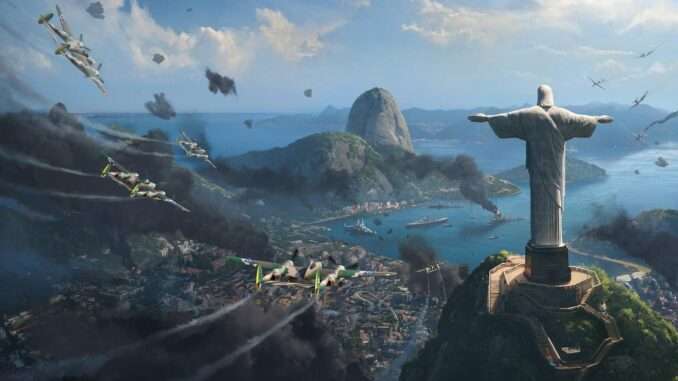
Some information and basic/advanced division templates for any level of player.
Division Templates Guide
Here’s a breakdown of some division templates that are generally effective in most scenarios within the game. Some other templates are more specialized and won’t be used as often, but it’s still good to be aware of them for particular situations.
Note: These Divisions are compatible with all game versions, so you don’t need to worry about which version you’re playing.
Infantry Divisions
All of these (excluding the Anti Tank Division) are your typical line infantry. They should serve you well whether it be holding your front line or seizing enemy land.
20 Width Infantry Division
A good starter division to use for lower manpower/industry. Highly recommended you upgrade this to the 40 Width.
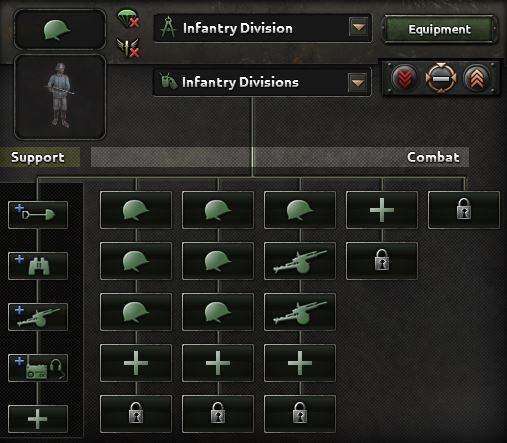
40 Width Infantry Division
A great division to use for the rest of the game. Requires a good amount of manpower/industry to maintain infantry. Will probably be used for most of the game.
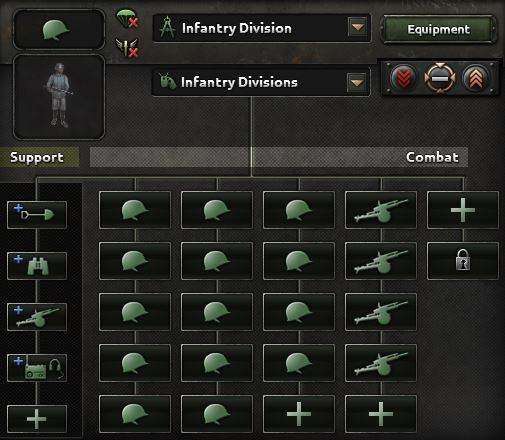
10 Width Weak Infantry Division
A division good for nations that have very low/non-existent manpower/industry. You want to get off of this template and onto the 20 width as soon as possible, but don’t go straight for it if you can’t afford it.
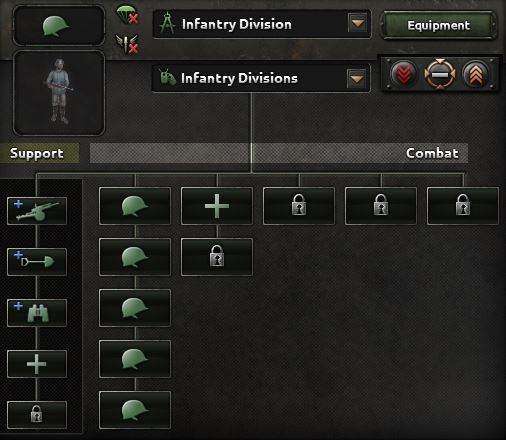
Anti Tank Division
A division great for keeping near locations where enemy armor is. This division will shred enemy tanks.
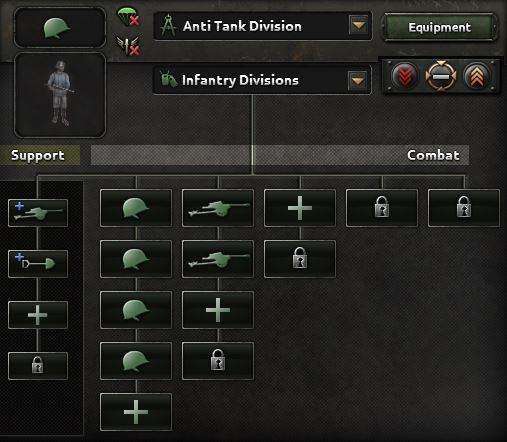
50 Width Chubby Infantry Division
For a country with a very large population, such as China or the former British Raj, it can be beneficial to dedicate fewer factories to producing manpower. This allows you to allocate more factories to other types of production.
To further enhance your military capabilities, it is advisable to invest in Support Artillery or Anti-Tank units for increased damage output in combat.

Special Infantry (Mountain, Paratropers, Marines)
Basic mountain
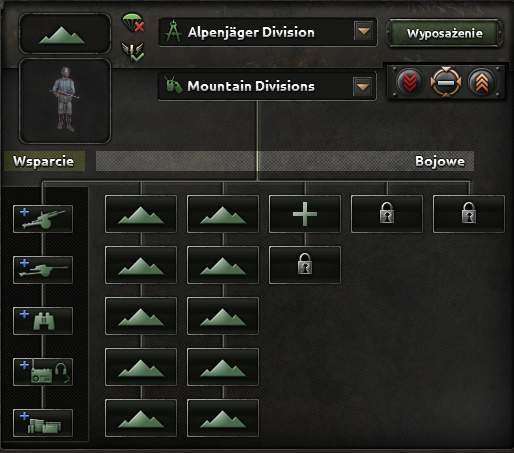
Better mountain
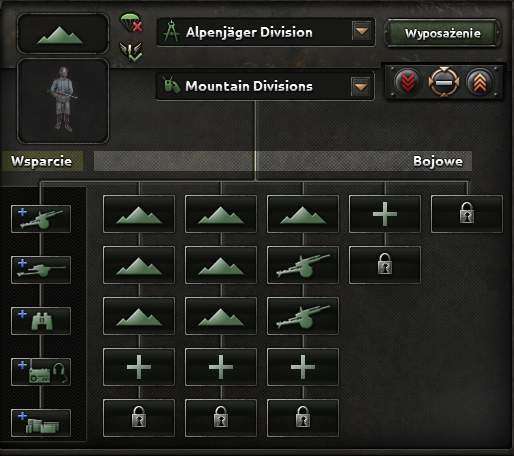
Paratropers
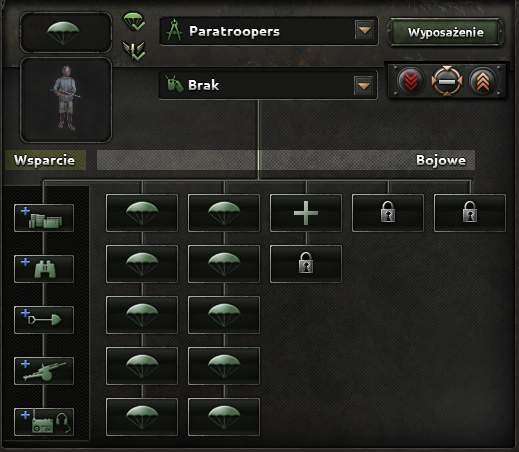
Marines

Tank Divisions
Light Tank Division (With SPA)
This is a light tank division that’s very quick compared to their medium cousins that can make encircling the enemy a breeze. You can use more Light Tanks if you can’t get SPA (Self Propelled Artillery) but for that extra damage I highly recommend it.
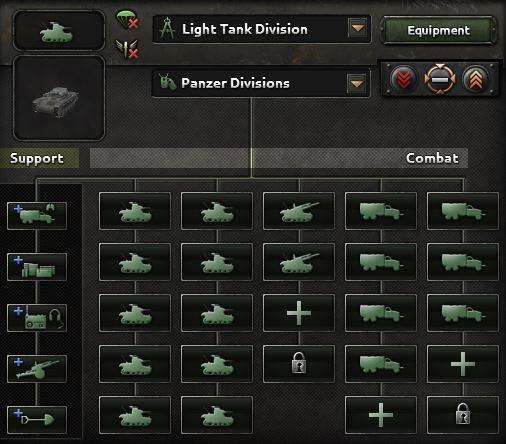
Medium Tank Division
This is the tank division I use almost always when it comes to tanks. It’s armor and ability to encircle and break/defend lines is incredible. I highly recommend using this template.
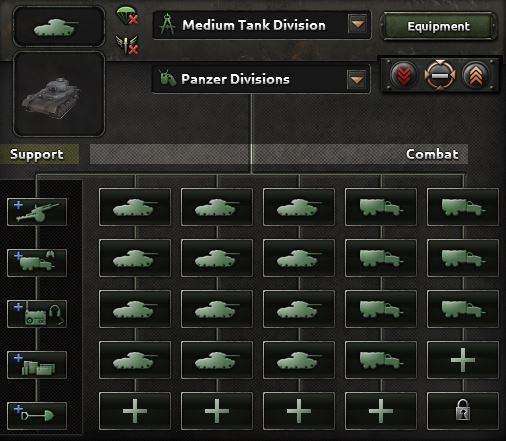
Aquatic Tank Division
This is division is the one I use the least, not because it’s bad or anything, but because it’s the biggest situational division on this list. This division is good for one thing really and that’s breaking through River lines.
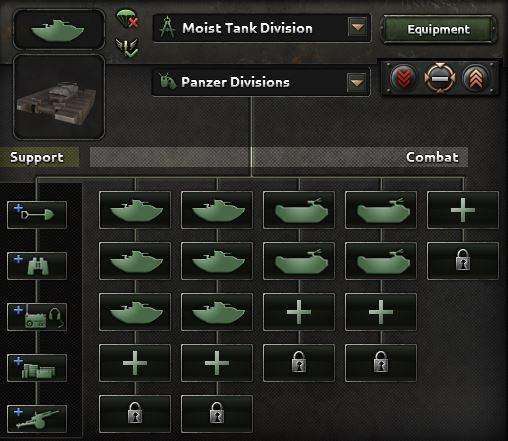
Special Forces
20 Width Marine Division
A good marine division for securing enemy coasts, recommended you upgrade to the 40 width asap.
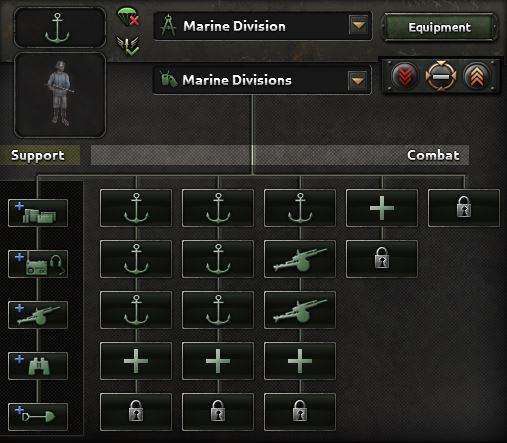
40 Width Marine Division
A great marine division for securing anything that touches the water. Recommended you only use marines to attack beaches, with a follow up of infantry or tanks to create your new line.
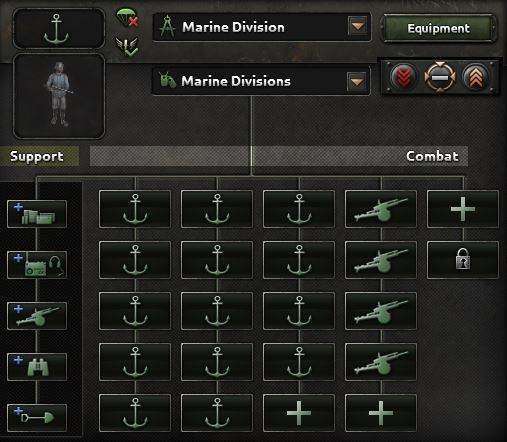
20 Width Mountaineer Division
Good division to fight in mountain regions, once again, recommended you upgrade to 40 width.

40 Width Mountaineer Division
Great division for pushing and defending any mountain region.
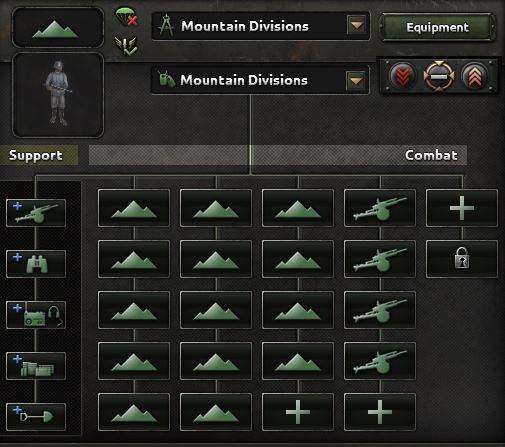
10 Width Paratrooper Division
A smaller paratrooper division useful for dropping behind enemy lines with the intent to encircle.
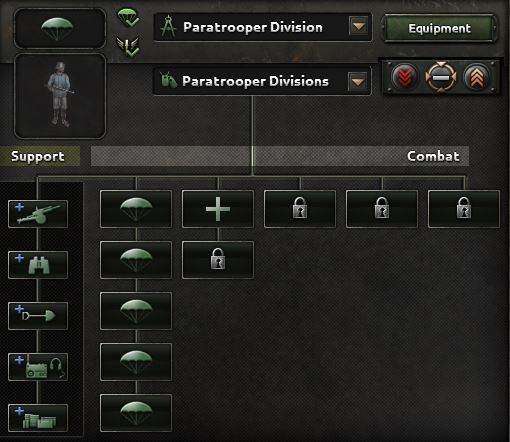
20 Width Paratrooper Division
A bigger paratrooper division useful for securing tiles behind enemy lines and actually being able to defend them.
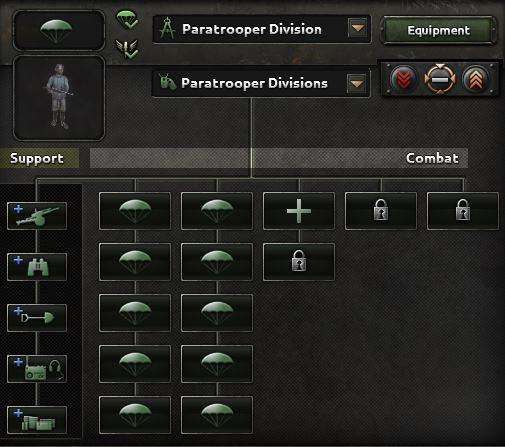
Mobile Divisions
I wouldn’t necessarily recommend using motorized only divisions, although they’re very fast they’re also very costly in fuel. Mechanized only divisions would be a better fit for cooperating with Tank Divisions.
Motorized Division
Good for going brr in areas that are flat biomes. Very costly in fuel.

Mechanized Division
Mechanized is good for later gameplay. They have great defense and can be super useful for containing infantry in encirclement pockets.

Garrison Divisions
The only Garrison units that I use are the Military Police. They’ll make sure those pesky rebels and traitors sit tf down and stop messing with your occupation.
Military Police
Military Police units provide a percentage bonus when suppressing rebellions. Some players prefer to use a lot of Cavalry units, while others use only three in a template. I recommend using 5 Cavalry units because it’s too expensive to put many Cavalry in a single division. It’s better to train fewer divisions that are more effective.
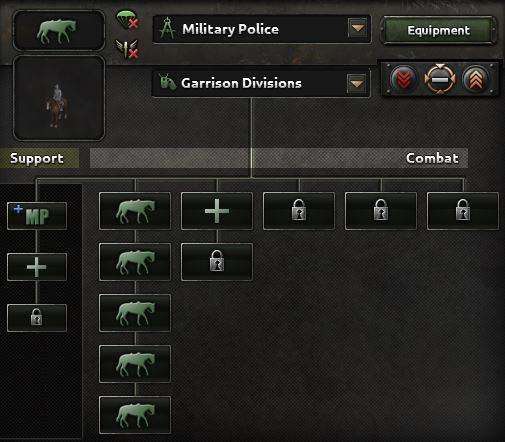
Support Companies
If we don’t need a company, we do not take it! Each additional company, apart from some positive value, worsens other statistics of our division.
- Maintenance companies decrease negative effects during combat and improve how quickly a division can move through challenging terrain. Furthermore, they enable the division to entrench itself, which significantly improves its ability to defend when it is stationary.
- Field hospital reduces the loss of human resources and the loss of experience as a result of incurred losses.
- Logistics reduces the consumption of supplies and fuel. Useful when fighting in areas with a very low infrasructure factor, or when you use a lot of mobile equipment.
- Engineers increases the reliability of a Division’s equipment, which reduces equipment losses due to exhausion or combat. Additionally, it allows you to “steal” the enemy’s equipment during fights.
- Recon increases the reconnaissance value of a division, which increases the chance of countering enemy tactics in combat.
- Signal significantly increases the organization of the division and the Initiative.
- Military police increases the value of pacification, making the division better able to deal with rebellions and guerrillas.
- Anti-aircraft artillery increases anti-aircraft defense.
- Anti-tank artillery support increases hard attack and penetration.
- Artillery support increases soft attack and defense.
- Rocket artillery support increases soft attack and breakthrough.
Basic Universal Templates
20 width Infantry Division
In the game Hearts of Iron, or when watching videos about it, players often discuss the 20 width infantry division. This division setup is useful for both defending territory and attacking enemy positions. It can consistently maintain defensive lines, allowing more specialized units to advance. It is a cost-effective choice suitable for both smaller and larger countries within the game.

You can use 10 infantry battalions (picture above) or 7 infantry battalions and 2 artillery, known as a 7’2. The 7’2 has more soft attack (because of the artillery) but the 10 infantry battalions have more defence, making the 10 infantry battalions good for defence of lines and the 7’2 good for offensives, these are cost effective divisions that are good for minors and majors.

You can also add multiple support companies, the first of which is recommended being the engineer division, then recon artillery signal companies etc.
40 width Infantry Division
The 40 width division, is strong and relatively expensive and more accessible if you are a major.

This division is known as the 14’4 because of the 14 infantry and 4 artillery battalions.
This division is good for both defence and offensives and can be changed to have more artillery or infantry battalions depending on the players needs. Adding several support companies can be good as well, for example if you’re looking to combat tanks use Anti-Tank or if you want to re-enforce manpower and equipment quicker you can use support companies increasing initiative.

I recommend this division for countries like the USA, USSR and Germany due to its cost – although quite heavy and impractical in mountains and hills this division will serve well late game with its Anti-Tank capabilities and huge amount of firepower. This division is also boosted a considerable amount by the superior firepower doctrine.
Marine Divisions
Depending on your plans marines can be very useful, and getting a good template for them is necessary to make a beach head. This is especially useful if you’re playing as the UK/USA and need to land a D-Day, which although being easier in singleplayer if you leave it too long you may need better divisions.
The standard 14’4 just made up of marines rather than standard infantry with engineer company can be very effective. Or if you do not have the resources then you can use a 20 width:
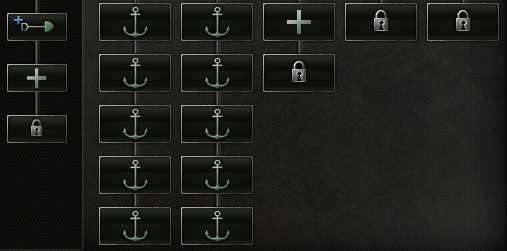
If you feel like doing something different and have DLC you could use amphibious tanks, like this:

20 width division using marines and amphibious tanks.

40 width division using marines and ampbibious tanks.
The amphibious tanks are more useful for countries with more industry but can be achieved by smaller nations.
You can also use an exploit to get more special forces. Create loads of 2 width divisions and then convert them to unequipped 50 widths. This will increase the special force cap and then you can convert some of the divisions to the marines and get a lot more of the marines.
Notes:
Several countries start with a division template that can be edited to form an average 20 width division:

Changed to this:
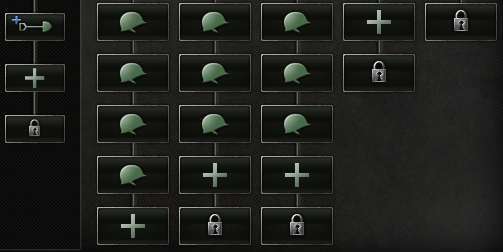
For example Germany and the UK, this can not only make slowly progressing to larger and better divisions easier but give you more time to do so and keep a small step ahead of the AI for a few in-game months.
Where and How to Edit Division Templates
You can edit division templates by going to:
- Recruit & Deploy -> Then click “Edit” on the desired division.
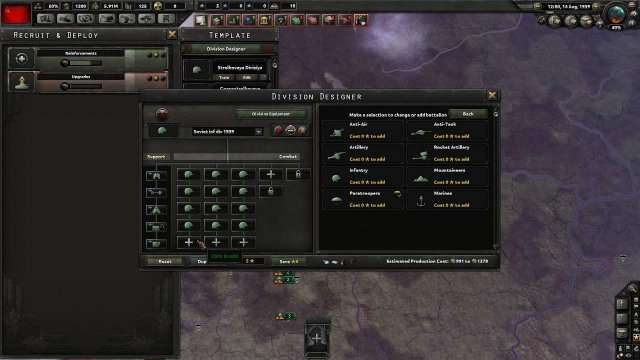
Each division has a division template. Here is an example of a 7 Infantry – 2 Artilery division template:
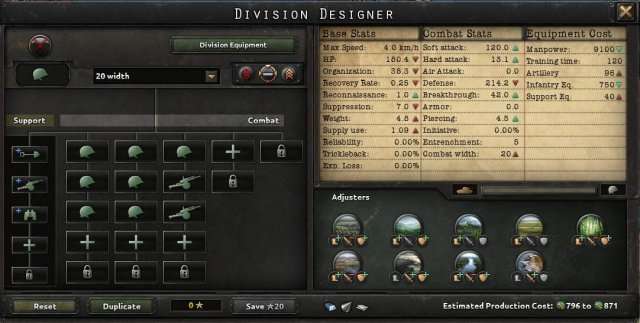
- Reset -> Reset the edits you’ve made but haven’t saved.
- Duplicate -> Create another division template just like this one without spending army experience, useful if you want to make a new division template while still keeping this one.
- The 3 Arrows -> Divisions marked in red are for backup. These units will be the last to receive new or additional equipment. Divisions in white are your standard units. They will receive equipment at a normal rate. Divisions highlighted in yellow are your elite units. These divisions will be prioritized and will receive new, higher-quality equipment first. If there’s a shortage of equipment, elite units will also be the first to have their needs met. You have the ability to manually set which of your divisions you consider to be elite, normal, or backup.
This is how a division looks like:
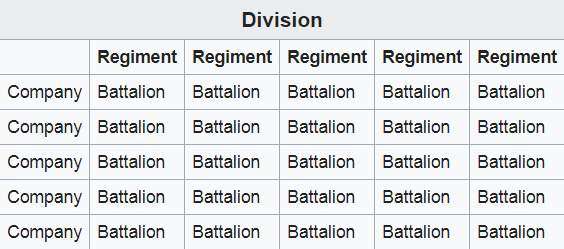
- Each division consists of up to 5 combat regiments and 5 support companies.
- Each combat regiment is composed of up to 5 battalions.
- It costs 5 XP to add a battalion to a division, regardless if it is the same or new regiment.
- Adding a battalion of a different unit type (infantry, mobile, or armored) adds a penalty of 20 XP per additional unit type.
- A division may have any number of the same unit type for battalions, but only one of each unit type for support companies.
- A division template may be specified as reserve, regular, or elite. Elite divisions will be prioritized for better equipment, followed by regular divisions and finally reserves.
- Each division template can receive specific types of equipment if multiple types are available. An example would be elite divisions only using the latest weapons and reserve divisions using the oldest.
The Stats Screen and Base Stats
Base Stats, Combat Stats are Equipment Cost located on the right side of the division template. These are the stats for the 7 Infantry – 2 Artilery division from above.

The stats may change based on your national ideas or completed researches. Universally speaking, higher values are better except for Weight, Supply Use and Combat Width.
Base Stats
- Max Speed -> The base maximum speed a unit can go, this value is usually lower due to terrain and infrastructure modifiers, however certain things increase this such as engineers.
- HP (Hitpoints) -> How much damage your unit can take during combat. Infantry and variants have a lot of this because they are many, while armor has very little.
- Organization -> This is very important. It’s your unit’s ability to sustain combat. It is important to keep it in the back of your head, but not make it dictate your unit composition. Provided primarily by infantry and motorized or mechanized. It’s usually between 25 and 60.
- Recovery Rate -> How fast your units will regain organization. Recovery is as important as organization. However, since most units that provide recovery also provide organization, these values usually balance each other out. It’s usually between 0.30 and 0.44.
- Reconnaissance -> High reconnaissance increases the chances of a unit to pick a combat tactic that better counters the enemy’s chosen tactic. It is only affected by 2 things: whether you have support battalions & whether you have Shock&Awe research of the Superior Firepower doctrine or Infiltration in Depth of the Grand Battleplan doctrine. Both of these doctrines are at or near the very end of their trees, thus your recon value is usually equal to your recon batallion’s level with values between 1 and 7 with an absolute maximum of 8.
- Suppression -> Whether you’re albe to keep the revolts in an occupied territory in check. Suppression has very few things that affect it, cavalry is good for suppression, providing 2 per cavalry while most other units provide 1 and the Military Police provides a 10% modifier to the unit value. In combat it doesn’t offer anything and is pretty neglectable.
- Weight -> How many convoys it takes to ship your unit. Only important for countries that have to ship their units by sea. Very closely related to Supply Use, but then without any actual meaning.
- Supply Use -> How much supply use your units use (press F4 in game to see the supply lines), which directly translates to how many units you can have in any given province. As a general rule: Infantry uses very little supply, tanks use a lot of supply, Logistics Company support company is indispensible.
- Reliability -> Affected only by the Maintenance Battalion, Reliability is a modifier to the base reliability of a vehicle (such as the effect of a tank designer). This applies to vehicles only. As far as I can tell it affects mostly during attrition, and doesn’t appear to have the same combat effects as reliability does for ships.
- Trickleback & Exp.Loss -> Trickleback is how many casualties are returned to your manpower pool and exp.loss is how much experience is lost when these casualties are replaced by fresh men. They only change with the use of a Field Hospital battalion. This makes the Field Hospital support company extremely important for nations with a low manpower pool.
Combat Stats and Equipment Cost
Combat Stats
- Soft Attack -> Generally, infantry units have a very low soft attack value. Tank units also have a relatively low soft attack. Artillery units and self-propelled gun units possess extremely high soft attack values. Many players, including the game’s artificial intelligence, tend to create armies that are composed of 90 to 100 percent infantry. Because infantry units are vulnerable to soft attacks, the soft attack statistic is a very important factor to consider when evaluating units.
- Hard Attack -> A unit’s ability to deal hard damage to tanks and mechanized units. Tanks and Anti-Tank guns have high hard attack.
- Air Attack -> A unit’s ability to shoot at planes. Support AA (Support battalion) is more cost-effective than line-AA for air-attack purposes. Support AA or Line-AA is the most cost-effective (production-wise) AA when you take the researches for this.
- Defense -> A unit’s ability to not break under attack. Absorbing damage that would otherwise have gone to a unit’s organization. This value is provided primarily by Infantry and derivatives. For armored units, this alone makes motorized or mechanized indispensible as without it your units are simply unable to defend.
- Breakthrough -> A unit’s ability to break the enemy units under attack. Breakthrough is less relevant than defense for the typical player as you want to hold the ground that you take, having enemies bleed off their organization on the attack and counter-attacking to maintain momentum in a push. It’s usually around 150.
- Armor -> A unit’s ability to resist the enemy’s piercing. When the enemy cannot pierce, you take 50% less damage, 50% less organization loss and you deal 50% more organization loss to the units you are facing, this bonus is applied to your entire division. Thus, armor alone can make a unit work, even if on paper it seems hopelessly outclassed. Armor values are one of the things that develop extremely quickly between armored vehicles. Not very useful unless you have enough of it.
- Piercing -> All piercing does is deny the enemy the bonuses armor could provide him. Units with the highest piercing are tank destroyers followed by regular tanks. Although infantry anti-tank provides good piercing to all infantry units it will prove insufficient if you are facing a clever enemy in multiplayer, as the piercing bonus is based on a percentage value and will have a limited impact on actual stats.
- Initiative -> The reinforce rate and planning speed. It is affected only by the signal company, and seems to have very little tangible impact on battles other than the planning bonuses.
- Entrenchment -> Affected only by the Engineer Company support battalion, Entrenchment affects how much and how fast a unit gets entrenched. Very similar to Recon, Reliability and Initiative, there are very few things that affect this value, and it is universal regardless of which line units you employ. While Field Marshalls with “Defensive Doctrine” affect maximum entrenchment it is not represented in this stat.
- Combat Width -> How much space the unit takes on the battlefield. A typical fight has 80 combat width, thus you could fit 8 units of 10, 4 units of 20, 2 units of 40 or 1 unit of 80. Each combat width range is representative of an approach to the game. When you make many units of 10 combat width, you increase the density of support battalions on the field, effectively increasing your entire army’s effectiveness at no additional cost of combat width. The 40 combat width aims to get the most out of its line units. The 20 combat width is the balanced method. If you get a Field Marshall with Offensive Doctrine, which reduces the combat width of all units under his command by 10%, you can create units of 11, 22 and 44 combat width respectively and have them all act as if they are 10, 20 and 40 combat width.
Equipment Cost
- Manpower -> A larger number of men in a division means more units will be present in combat, but it also means potentially higher casualty numbers. Generally, it’s preferable to keep this number relatively low, but it shouldn’t be the primary focus when designing divisions, as it’s difficult to optimize in isolation. Typically, artillery units added to a division and armored units each contribute about 500 men to the division’s size. Infantry units add approximately 1000 men, while motorized and mechanized units contribute around 1200 men per unit in the division.
- Training Time -> There are two versions of training time, 120 and 180. 120 is for infantry and 180 for tanks. This is a time listed in days, but since Armor = 180, Infantry = 120, you just have to take this value as it is.
- Equipment numbers -> All the individual numbers of vehicles and other equipment you would require to produce this division template. It is here that you can make a good estimate of how to distribute your overall production.
Additional Stats
- Hardness (the bar below the division template) -> The ratio of damage you take. If your unit has 43% hardness you take 57% soft attack and 43% hard attack. For example, if you are being attacked by a unit with 1000 soft attack and 200 hard attack, you will receive (1000 * 0.57) + (200 * 0.43) = 656 damage.
- Estimated Production Cost -> The minimum and maximum estimated production cost of a unit. These values represent the overall production cost in industrial capacity of your unit, and do not represent the material requirements of each division. Naturally a lower cost is better.
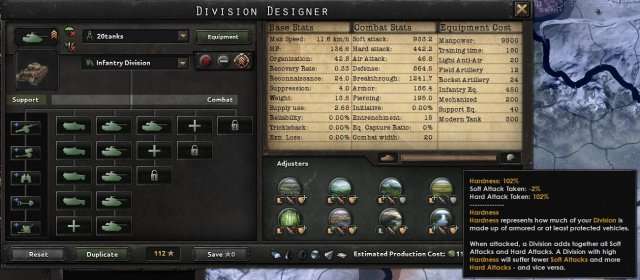
Useful Tips
- Maintenance companies & Attrition -> Attrition is mostly caused by terrain not supply. So if you are fighting in the jungle, desert or mountains you will suffer a lot of attrition. Maintenance companies will reduce attrition taken. You can also just accept the losses taken.
- AA divisions & Strategic Bombers -> No division AA only protect the divisions they are in and not the province or anything else. They reduce the defense and speed penalty from enemy air superiority. They will also shoot down close air support engaged. But they have to be engaged inside combat.
- Breakthrough & Defense -> Breakthrough is identical to defense in function. When you are on the offensive you use breakthrough when on the defense you use defense. These just reduce damage taken. There is a limit as every defense can only reduce 1 point of enemy attack.
- Mechanized & Heavy Tanks -> Mechanized are a defensive upgrade for tanks with a secondary role of AT. Hardness greatly reduce damage infantry/mediums can do, defense helps protect from counter attack, and HP reduces losses. The higher the tech and more tanks the better these are. Heavy tanks provide armor, and AT mostly at the cost of speed. You only need 1 heavy tank to get the majority of armor at the cost of speed.
- 40 width & 20 width -> 40 width is stronger in most situations. It’s less flexible but stronger in combat.


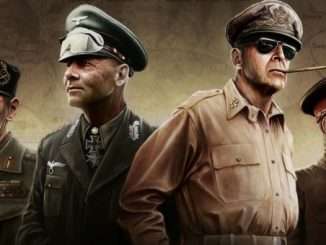
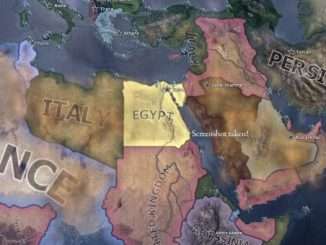
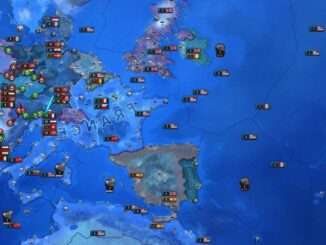
i would recommend using support-AA instead of support-Artillery , beside that great template’s
good job, although I know most of these it is good for starters keep it up!
I’d strongly recommend field hospitals for line infantry, they’re just incredibly useful. I like armored cars for garrisons
Armored cars (if you have that DLC and have the production to make them) are great for garrisons or adding armor (and much later AT piercing) to motor cavalry. Even the 1940 armored car can keep pace with motor infantry.
I’d also suggest considering rocket trucks for countries that are planning to go way in on motor cav, since they can be utterly devastating, but rockets do require fairly significant tech investment to really reach their pinnacle.
A few suggestions:
For 10 width division, just forget support battalions. You can almost convert it to a 7-2 with all those extra production costs!
50 width should not be recommended, I’m not sure about India, but you can use 7-2s even if you are playing China, and it’s much more efficient in terms of production and army xp
7-2 division is well and fine, but 4 support battalions may be too much, at least for some countries. They raised the cost by almost 50% compared to no support battalion and will decrease organisation from 60 to 45, and for your average frontline infantry, you would like to have high org and low cost. Adding support battalions will also cost a lot of army xp and is a luxury to many in the early game, so a 7-2 division with only 1 or 2 support battalion(like engineer) is a better generic template.
You should replace the 7-2 with only 10 infantry. You mainly want your infantry only for defending with your tanks making pushes. Also the cost of a 7-2 isn’t worth it.
I find pure medium/motorized to be underwhelming so I usually throw in 4 motorized artillery for that extra soft attack. I do usually play SP, but that’s just my two cents